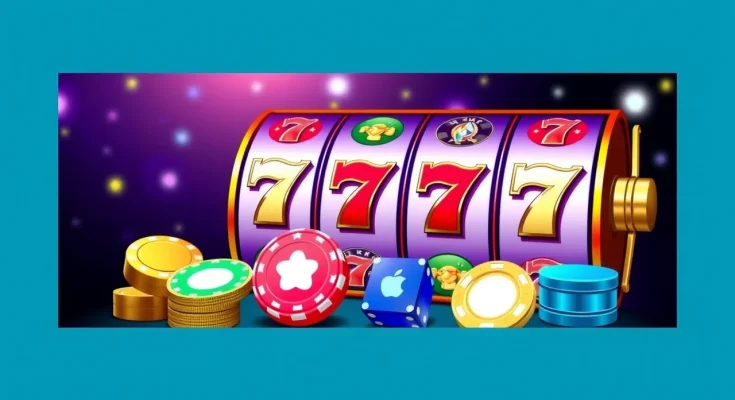You pull the lever—or more likely, tap the screen. The reels spin, a blur of color and light. Then, the symbols click into place. Two cherries… a seven… and another cherry. So close. Without even thinking, your finger is already hovering over the ‘spin’ button again. Ever wonder why it’s so hard to just walk away?
It’s not an accident. Slot machines, especially online slots, are masterclasses in psychological design. They’re not just games of chance; they’re carefully crafted experiences built on decades of behavioral science. Let’s pull back the curtain on how these games hook our brains and keep us engaged.
The sound and the fury: A sensory overload (in a good way)
Step into any casino, virtual or physical, and the first thing that hits you is the sound. It’s a symphony of psychological triggers. The celebratory jingles, the clinking of virtual coins, the rising musical pitch of a bonus round about to trigger—it’s all meticulously designed.
These sounds create a powerful association. Our brains learn that certain noises mean a win. And here’s the kicker: the brain’s reward system often fires just as strongly for these near-miss sound cues as it does for an actual win. That near-miss jingle isn’t a consolation prize; it’s a trigger to try again.
Variable rewards: The slot machine’s greatest trick
This is the big one. It all goes back to the work of psychologist B.F. Skinner and his famous “Skinner Box” experiments. He found that rats would press a lever most frequently when the reward was unpredictable. Sometimes they’d get a pellet, sometimes they wouldn’t. This is called a variable-ratio reinforcement schedule.
Slot machines are the ultimate Skinner Box for humans. You never know which spin will be the big winner. That uncertainty is incredibly compelling. It’s the same psychological principle that keeps us compulsively checking our phones for notifications. The “maybe this time” thought is a potent motivator.
Near-misses and the “almost won” effect
Seeing two high-paying symbols on the payline with the third just above or below it is a classic near-miss. Logically, it’s a loss. But our brain doesn’t always process it that way. It interprets it as a “almost win,” which feels tantalizingly close to a real victory.
This near-miss effect actually stimulates the same brain regions associated with winning. It tricks us into believing we’re developing skill or that we’re “getting warmer,” encouraging us to continue playing. Game designers carefully calibrate the frequency of these near-misses to maximize that feeling.
The illusion of control
Slots are games of pure chance. There’s no skill involved in the outcome of a spin. But clever design creates what psychologists call an “illusion of control.” Features like “stop” buttons that let you halt the reels, or bonus rounds that require a simple choice (Pick a box! Shoot the goal!) give the player a sense of agency.
This feeling that our actions matter—even when they don’t influence the random outcome—makes the experience more engaging and, honestly, more enjoyable. We feel like active participants, not just passive observers of a random number generator.
Losses disguised as wins
Here’s a subtle but brilliant bit of design. A “Loss Disguised as a Win” (LDW) occurs when you get a winning combination, but the amount you win is actually less than your original bet. The machine still celebrates with flashing lights and exciting sounds.
Why does this matter? Because it provides the auditory and visual reward of a win without the actual financial gain. It keeps the player in a positive feedback loop, celebrating frequently even while their bankroll is slowly decreasing.
Themes, stories, and brand familiarity
Modern online slots aren’t just about bars and bells. They’re immersive worlds. From ancient Egypt to blockbuster movies and TV shows, themes create an emotional connection. Playing a slot based on your favorite band or film feels familiar and comforting. It lowers your guard and makes the experience about more than just money—it’s about entertainment and fandom.
How to engage consciously
Knowing all this isn’t meant to ruin the fun. Slots are designed to be entertaining! But awareness is power. Here’s how to keep your engagement healthy:
- Set a budget (and a time limit) before you even load the game. Treat it like the cost of a movie ticket.
- See the sounds. Try playing with the sound off once. You’ll notice how different the experience feels without its psychological soundtrack.
- Remember the math. The house always has an edge. View any wins as a happy bonus, not an expected outcome.
- Take breaks. Get up, walk away, and break the hypnotic rhythm of spin-spin-spin.
The final reel
The next time you see those reels spin, you’ll see more than just a game. You’ll see a complex interplay of light, sound, and psychological principle designed to create a compelling loop of anticipation and reward. It’s a fascinating, and incredibly effective, piece of behavioral architecture. The real jackpot is understanding the game behind the game.




